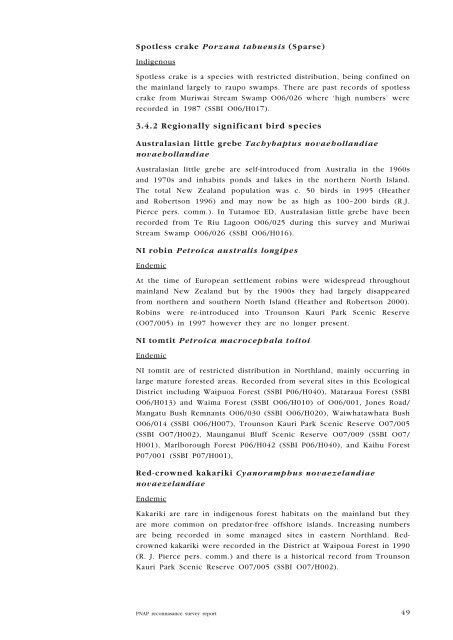Natural areas of Tutamoe Ecological District (3. Ecological character)
Natural areas of Tutamoe Ecological District (3. Ecological character)
Natural areas of Tutamoe Ecological District (3. Ecological character)
Create successful ePaper yourself
Turn your PDF publications into a flip-book with our unique Google optimized e-Paper software.
Spotless crake Porzana tabuensis (Sparse)<br />
Indigenous<br />
Spotless crake is a species with restricted distribution, being confined on<br />
the mainland largely to raupo swamps. There are past records <strong>of</strong> spotless<br />
crake from Muriwai Stream Swamp O06/026 where ‘high numbers’ were<br />
recorded in 1987 (SSBI O06/H017).<br />
<strong>3.</strong>4.2 Regionally significant bird species<br />
Australasian little grebe tachybaptus novaehollandiae<br />
novaehollandiae<br />
Australasian little grebe are self-introduced from Australia in the 1960s<br />
and 1970s and inhabits ponds and lakes in the northern North Island.<br />
The total New Zealand population was c. 50 birds in 1995 (Heather<br />
and Robertson 1996) and may now be as high as 100–200 birds (R.J.<br />
Pierce pers. comm.). In <strong>Tutamoe</strong> ED, Australasian little grebe have been<br />
recorded from Te Riu Lagoon O06/025 during this survey and Muriwai<br />
Stream Swamp O06/026 (SSBI O06/H016).<br />
NI robin Petroica australis longipes<br />
Endemic<br />
At the time <strong>of</strong> European settlement robins were widespread throughout<br />
mainland New Zealand but by the 1900s they had largely disappeared<br />
from northern and southern North Island (Heather and Robertson 2000).<br />
Robins were re-introduced into Trounson Kauri Park Scenic Reserve<br />
(O07/005) in 1997 however they are no longer present.<br />
NI tomtit Petroica macrocephala toitoi<br />
Endemic<br />
NI tomtit are <strong>of</strong> restricted distribution in Northland, mainly occurring in<br />
large mature forested <strong>areas</strong>. Recorded from several sites in this <strong>Ecological</strong><br />
<strong>District</strong> including Waipuoa Forest (SSBI P06/H040), Mataraua Forest (SSBI<br />
O06/H013) and Waima Forest (SSBI O06/H010) <strong>of</strong> O06/001, Jones Road/<br />
Mangatu Bush Remnants O06/030 (SSBI O06/H020), Waiwhatawhata Bush<br />
O06/014 (SSBI O06/H007), Trounson Kauri Park Scenic Reserve O07/005<br />
(SSBI O07/H002), Maunganui Bluff Scenic Reserve O07/009 (SSBI O07/<br />
H001), Marlborough Forest P06/H042 (SSBI P06/H040), and Kaihu Forest<br />
P07/001 (SSBI P07/H001),<br />
Red-crowned kakariki cyanoramphus novaezelandiae<br />
novaezelandiae<br />
Endemic<br />
Kakariki are rare in indigenous forest habitats on the mainland but they<br />
are more common on predator-free <strong>of</strong>fshore islands. Increasing numbers<br />
are being recorded in some managed sites in eastern Northland. Redcrowned<br />
kakariki were recorded in the <strong>District</strong> at Waipoua Forest in 1990<br />
(R. J. Pierce pers. comm.) and there is a historical record from Trounson<br />
Kauri Park Scenic Reserve O07/005 (SSBI O07/H002).<br />
PNAP reconnasance survey report<br />
49

















